- Scrutinizing Issues in the Performing Arts Scene Arising from COVID-19 -
Cho In-seon (CEO of Modern 韓)
Online: An Era of Watching Performances in the Front Row, in Your Room
The coronavirus has made a serious impact on the performing arts scene throughout the first half of 2020. Many of the performances had to be either postponed or canceled. It is also expected to take quite a long time before theaters get back to normal. Under these circumstances, many of those in the performing arts scene have discussed how to present ‘untact’ performances through videos. Indeed, Korea’s national and public theaters have taken the lead in providing online performances on video platforms like YouTube and Naver TV. In many cases, these theaters have transformed their existing projects supporting artists into those producing and distributing performance videos. Such transformation of projects enable them to financially support performing arts companies as they produce their performance videos. The theaters also use the online platforms to share the videos they have kept in their archives.
With online performances shared actively online, those in the performing arts scene have raised concerns. They admit that they could try online performances in order to help people enjoy the arts and culture amid the spread of COVID-19, without having to visit theaters physically. However, they argue that such performances would not help those in the performing arts scene in a concrete way as they find it difficult to survive, with performances canceled or postponed. Nevertheless, as demand for online performances has surged lately, it is time to review and scrutinize extensively various issues regarding the online form of the performing arts. Such issues could include planning and producing videos, forming online platforms and distribution channels and addressing copyright problems.
Last April, Korea Arts Management Service (KAMS) met with those in the performing arts scene. On that occasion, KAMS and the participants discussed how to carry out online video projects in their field. The participants were Han Seung Won (CEO of HJ Culture), Dana Chie (professor of Arts and Culture MBA at Kyung Hee University), Ham Seongmin (leader of Naver Performance & Grafolio), Kim Mihui (head of Culture and Media Business Department at Seoul Arts Center), Shin Tae-yeon (assistant manager of Culture and Media Business Department at Seoul Arts Center), Kang Eun-kyung (President and CEO of Seoul Philharmonic Orchestra) and Ahn Young-soo (CEO of Rang (promotion and marketing company)). During the meeting, the participants reviewed the current state of the increased supply and demand of online performance videos and ways to distribute the videos. They also discussed how to conduct online video projects in a stable manner, from a long-term perspective.
It Is Essential to Separate Online Videos and Offline Stages for Their Complementary Effects
To begin with, the participants discussed how to ensure the complementarity between online videos and offline stages through paid online performances, for example. According to Ham Seongmin, numerous public organizations have asked him about sharing videos of their special performances since the onset of COVID-19. He said, “We are not trying to maximize the quality of filming and editing as in the case of Seoul Arts Center’s SAC ON SCREEN. Rather than that, we share highlights of performances or press calls in order to encourage viewers to watch offline performances. But from a long-term perspective, if there isn’t any paid system supporting our efforts, such videos may be used just for promotion and marketing purposes as in the past.”
Some participants also pointed out the need to strike a balance between online and offline performances. According to Ahn Young-soo, it is necessary to develop an online market because this could also lead to expanding the performing arts market as a whole and to finding new sources of profit. But he made clear that it would not be desirable to use one of the two forms to promote the other.
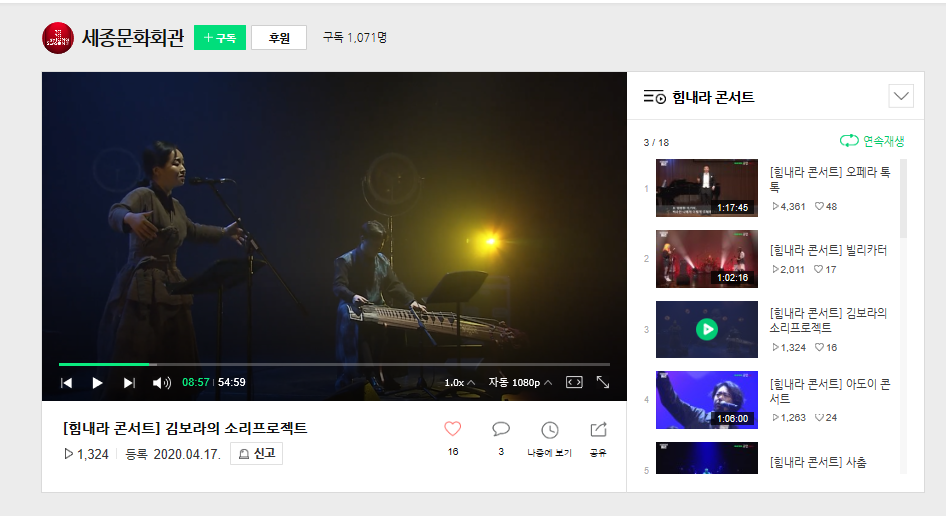
Performances without audiences broadcast live on Naver TV due to COVID-19
Source: Blog of Sejong Center
Performance Videos: Different Genres’ Issues and Cost Problems
When it comes to producing videos of performances and distributing the videos, we can’t avoid discussing differences in genres and cost problems. Han Seung Won said that expanding both online and offline markets would basically require an abundance of strong creative content. It means that in both online and offline spaces, the performing arts scene wouldn’t be able to move forward without securing a sufficient amount of high-quality content. Different genres’ different conditions are directly linked to the copyright issue. The participants’ remarks concerning different genres’ video production could be summarized as follows. First, as for classical music concerts, video production is facing numerous obstacles (e.g. orchstra members’ neighboring copyright) because orchestral performances are labor-intensive. Second, creative musicals or small and medium-sized performances could be shared through online streaming but video work would be difficult for performances with content sources or licensed performances. It will also be very challenging to present paid online performances, considering people’s psychological burden. Prof. Dana Chie said quite bluntly, “In Korea, it will be difficult to adopt foreign models like ‘The Met: Live in HD’ and the UK’s ‘NT Live’ as they are. That is because Korea’s performing arts market is dominated by national, public and nonprofit organizations and it doesn’t have any proper platform that would allow it to turn to private, commercial business. Even under such unusual circumstances, audiences who have always watched videos for free may be resistant to paid content.”
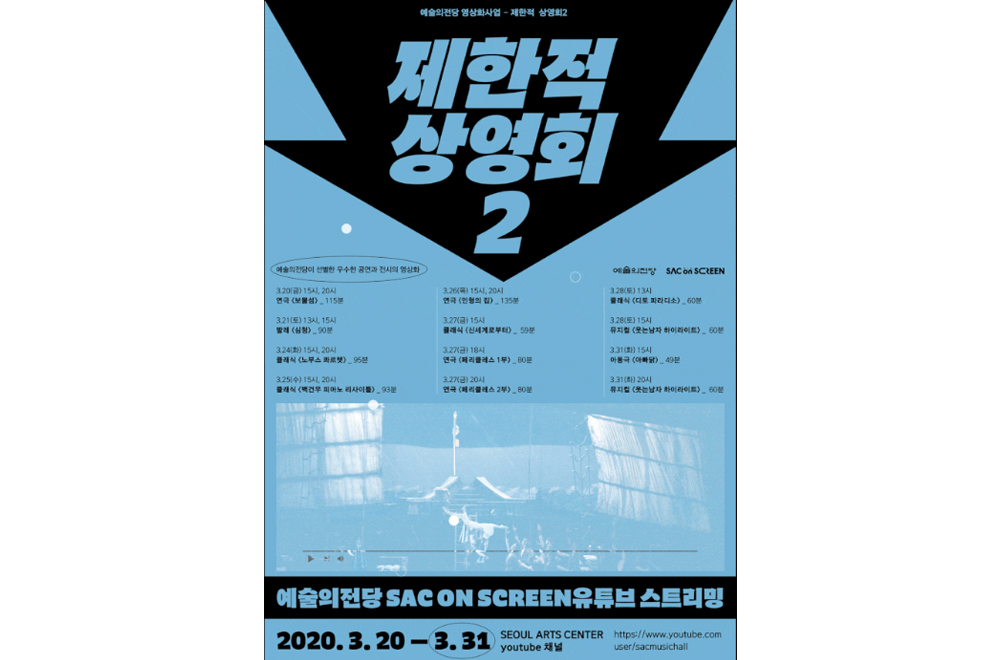
Seoul Arts Center’s SAC ON SCREEN (temporary YouTube streaming)
Source: Blog of Seoul Arts Center
Initial Public and Human Support Needed over the Long Run
Producing videos in the performing arts field has caused heated debates amid the COVID-19 outbreak. However, such debates would not bring immediate results or conclusions. Kim Mihui and Shin Tae-yeon, who are running SAC ON SCREEN at Seoul Arts Center, said that stability of video production wouldn’t be secured just with a couple of years of investment and that the work would be a long haul. According to them, high-quality videos require support for on-site staff and proper equipment. They added that in the beginning, video technicians and creators need to collaborate as much as possible and that R&D and training projects are also needed to that end.
Offline: Despite All This, the Audience Is Alive
Then, how could performances have continued despite people’s limited travel and consumption during the COVID-19 outbreak? We talked to Mr. Han Seung Won, CEO of HJ Culture, who actively shared what he thought of online performance videos during the meeting, and asked him about the current state of Korean performance production companies, agencies and theaters.
HJ Culture is currently presenting
For 2020, we had planned four performances, including a musical for children
In Korea, theaters began to stage performances again in March. Despite concerns, no confirmed case has been found among the audiences, performers and staff members, adding another success story to Korea’s fight against COVID-19. I’m wondering to which degree theaters have taken quarantine measures.
First of all, I have to say that I must be very prudent when mentioning our quarantine measures because we haven’t put an end to COVID-19 yet. I’ll just explain what we did in the theater. Every day, we had performers fill out a questionnaire asking them about their health conditions. We also minimized their gatherings or outside activities after shows. In this way, we made all-out efforts to prevent the spread of the virus among performers and staff members. We have also minimized people’s access to the theater. Only performers and the theater’s essential staff members are allowed to enter the theater frequently. I’m the production company’s CEO but I avoid going to the theater as much as possible. Audiences also participated in our quarantine measures actively. For example, they wore masks throughout performances. They didn’t shout in and out of the theater. When standing in line to get their tickets, they maintained a distance of one meter from others. They also filled out our health condition questionnaire actively. Everyone’s efforts paid off and we didn’t have any confirmed case from the theater. Like this, both performers and audiences did their best to follow quarantine guidelines and such resolute and fierce efforts made by them proved their mature citizenship. Although many of those in the performing arts scene are suffering amid the spread of the coronavirus, I’m convinced that our performances contributed to strengthening the bonds between artists and their audience.
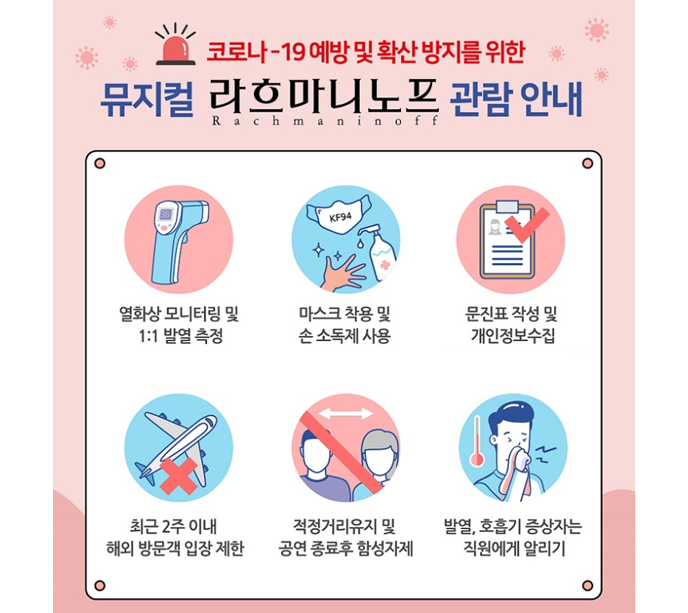 |
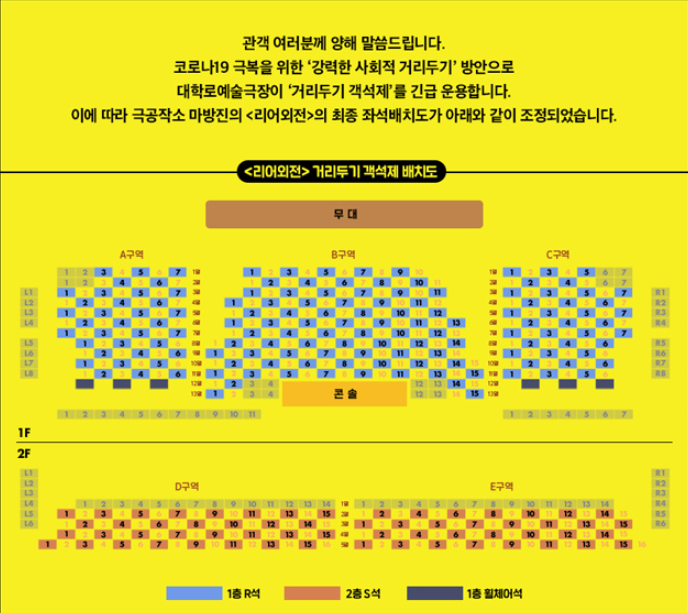 | |
Theaters implementing numerous quarantine measures to prevent the spread of COVID-19
Source: Interpark
The industries hardest hit by COVID-19 would be arts and tourism industries. The tourism industry estimates their losses by reviewing their data on cancellation of hotel reservation or on flight reservation. But it would be difficult for the performing arts market to estimate the exact volume of losses. What is the current state of losses that you feel in the performing arts field?
It is actually difficult to calculate the exact volume of losses which depend too much on performance sizes, genres and production types. Some of those in the performing arts scene postponed their performances, hoping that the COVID-19 outbreak would end in two to three months. Others are barely surviving with the government’s emergency loan. So we cannot estimate our losses just by relying on the current data. We are just waiting for the end of the COVID-19 outbreak.
It is true that local governments and relevant institutions have data on losses that have been collected through actual cases and the Korea Performing Arts Box Office Information System (KOPIS). Nevertheless, their statistics don’t include data on performances that haven’t agreed to share their information or those that don’t belong to an association or organization. So it is expected to take some time until they estimate the exact volume of losses.
In the context of ‘untact culture’ that has become dominant these days, many people are actively working on producing performance videos and distributing the videos online. As a producer, what do you think of such changes in the performing arts scene?
The spread of untact culture would have resulted in a frame, called ‘video production’ in the performing arts field. As people can’t go to theaters freely to watch performances due to COVID-19, video production of performances has been suggested as an alternative. Under these circumstances, arts organizations are taking the lead in making a breakthrough in the market by means of this alternative. Although their efforts could be viewed as positive, I wonder how delicately videos could preserve the communication between performers and their audience as well as touching moments in the theater.
I believe that this is rather an opportunity to experiment with different alternatives. In other words, video production of performances could be just one of the different options that may exist. Frankly speaking, the current sharing of performance videos, which is free of charge most of the time, is closely linked to our future profit models. Moreover, there are too many problems to solve, including development of online platforms specializing in broadcasting performance videos and stable transmission services. Considering this, it would be rather risky to focus too much on video production, as if it were the only solution for the performing arts scene in crisis. Instead, it is necessary to make diverse attempts so that we can choose from various alternatives according to different needs and artists’ conditions and resources. This is a challenge for all theaters, production companies and artists. It is important to be sensitive to social changes and to consider what choice to make in a given context.
*This contribution is a translation of the text appearing in the webzine Arts Management No. 445 (May 14, 2020).








 PREV
PREV
.jpg)
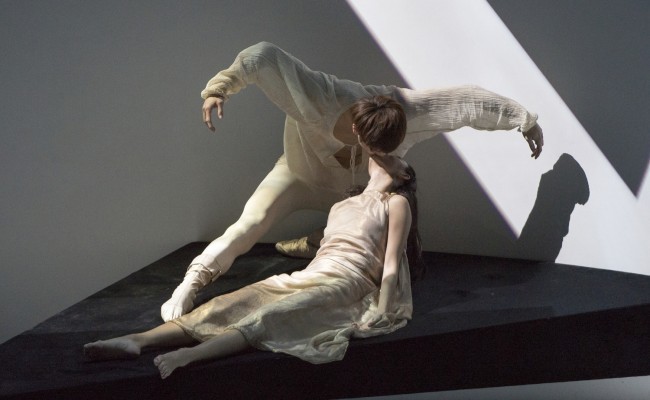
.jpg)
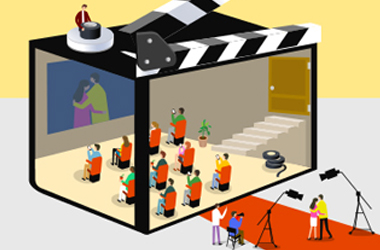
.jpg)
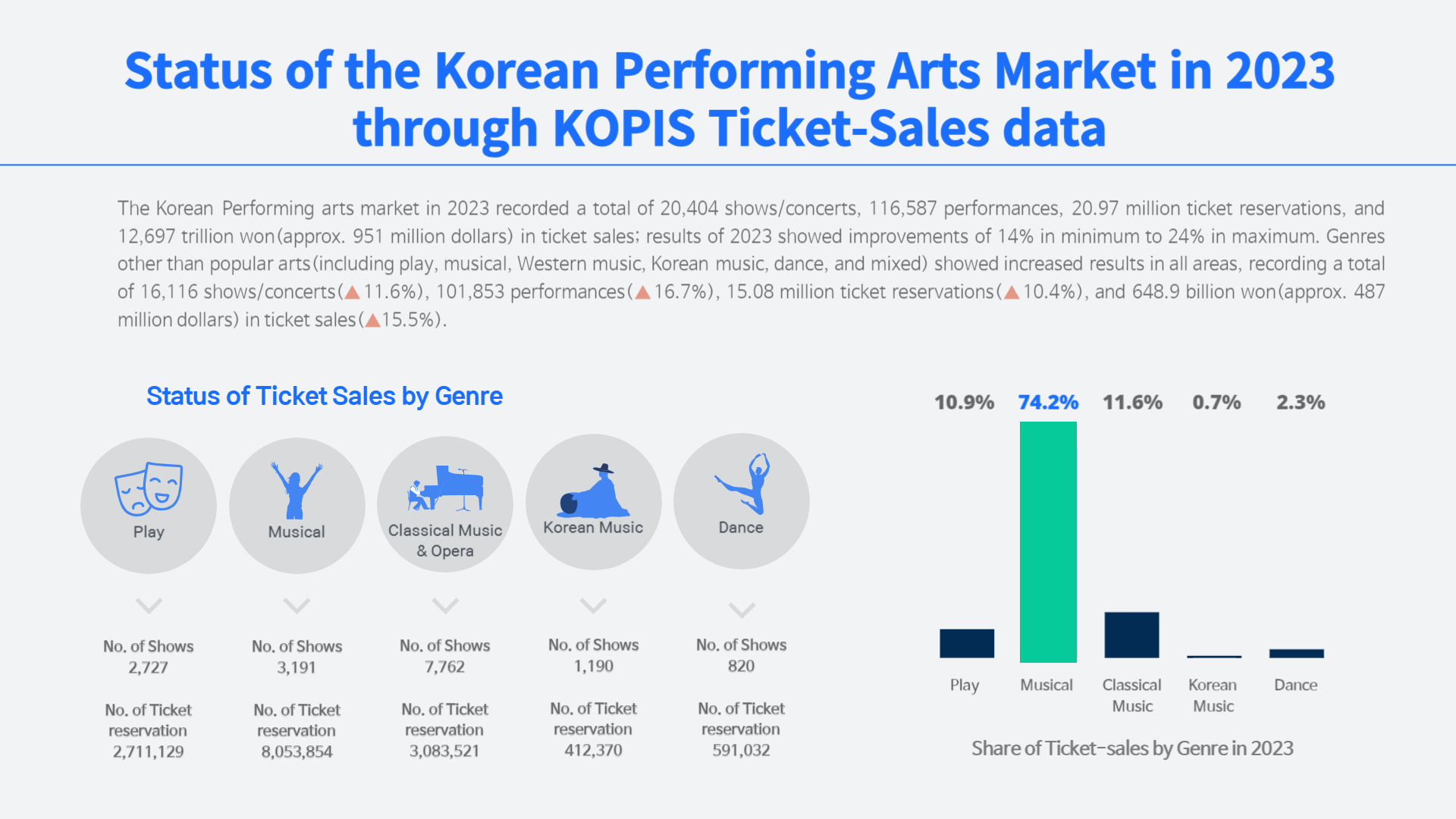
.jpg)
.jpg)
.jpg)
.jpg)











